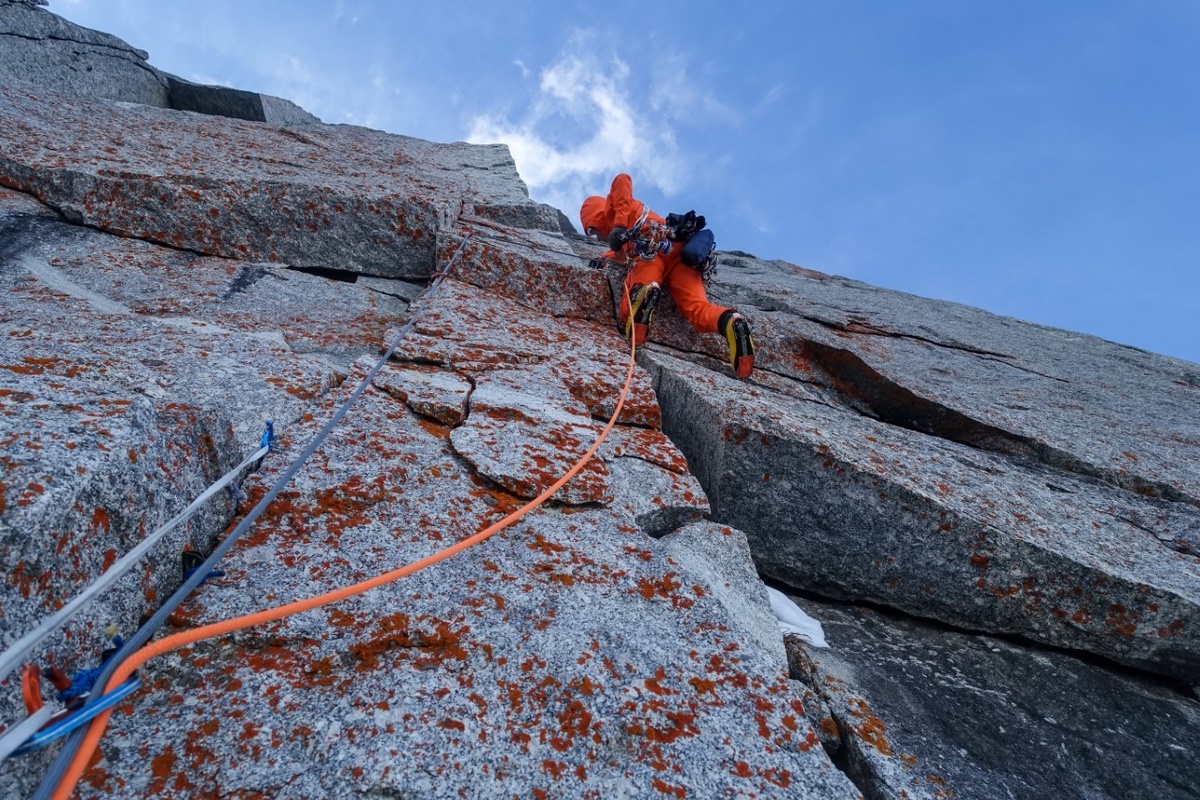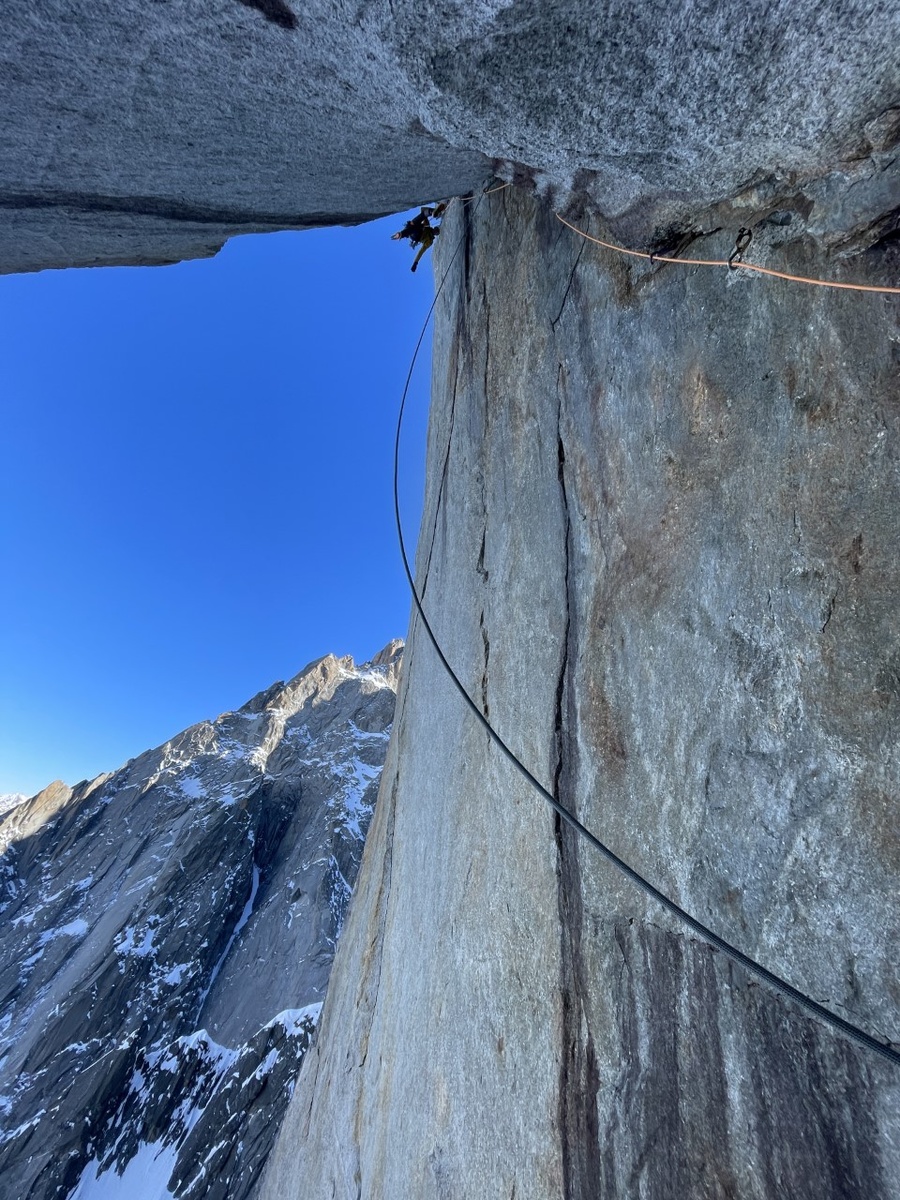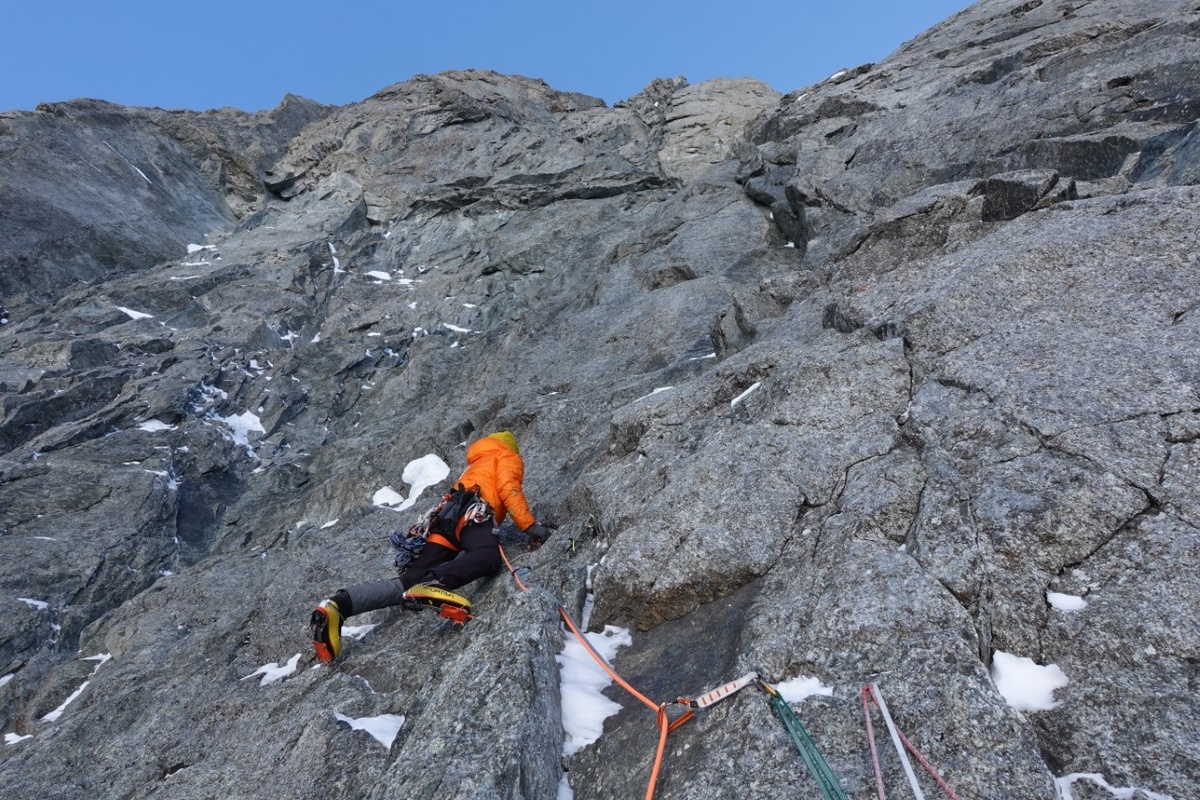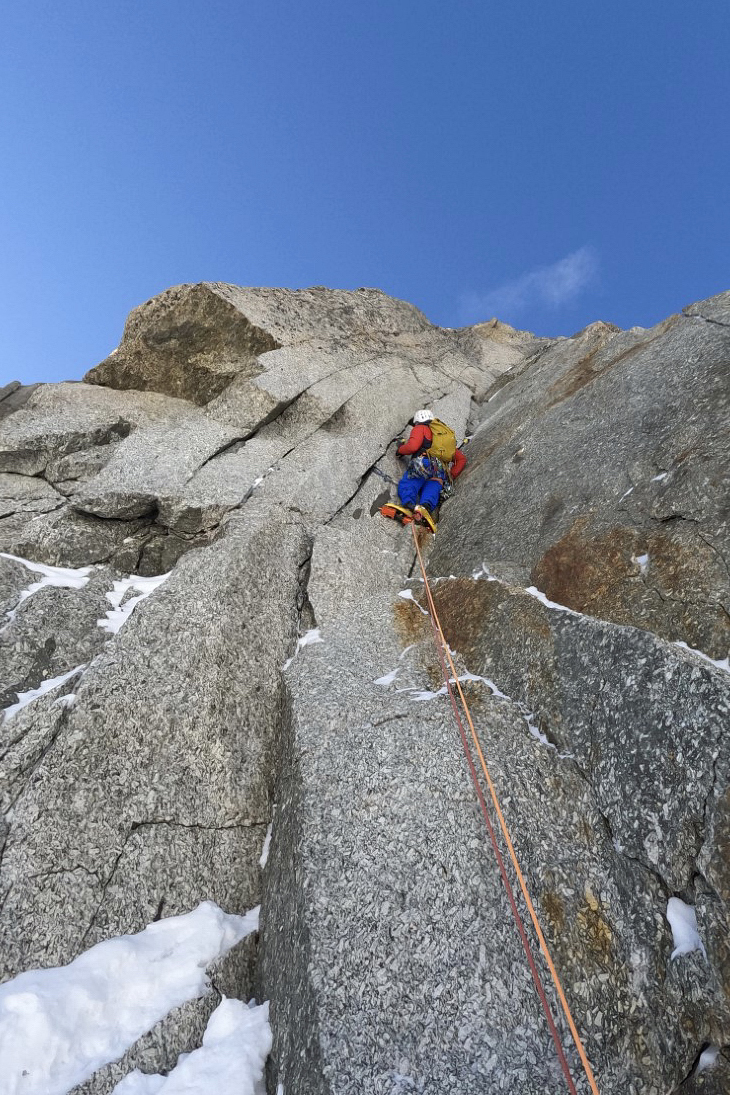Livingstone rounds off amazing winter in Alps
- Tuesday 4th April 2023
Climbing with various partners, Tom Livingstone has had another amazing winter season in the Alps climbing several cutting-edge mixed routes.
 Tom Livingstone has been smashing out cutting-edge mixed/winter routes from Scotland to the European Alps and the Greater Ranges now for some time. As previously reported, Tom’s 2021/22 winter season was action-packed with ascents of several impressive routes including the first free winter ascent of No Siesta on the North Face of the Grand Jorasses, Voies des Guides Route on Les Drus, a new route on Point Adolphe Rey and the Heckmair/1938 Route on the North Face of the Eiger in a day.
Tom Livingstone has been smashing out cutting-edge mixed/winter routes from Scotland to the European Alps and the Greater Ranges now for some time. As previously reported, Tom’s 2021/22 winter season was action-packed with ascents of several impressive routes including the first free winter ascent of No Siesta on the North Face of the Grand Jorasses, Voies des Guides Route on Les Drus, a new route on Point Adolphe Rey and the Heckmair/1938 Route on the North Face of the Eiger in a day.
Having sharpened his axes and crampons, Tom kicked the 2022/23 season off in early December at the Bozeman Ice Climbing Festival with a repeat of the classic Alex Lowe mixed route, Come and Get It.
Following a La Sportiva team meet in the Ecrins, Tom stepped up a gear in late January for a route on the North-West face of the Aiguille du Blaitiere with Rob Smith. They climbed the first five pitches of Mini Blast and then “followed their noses to the top”. Unsure whether it had been climbed before or not, the pair gave it a tentative name of M8 AK47 and graded it ‘tricky M6+’ although Tom did say that it was harder than several of the M7+ routes he’s climbed in the areas and that they gave it that grade because they feel that many of the mixed routes in the Mont Blanc Massif are over-graded. The route took them nearly three days to complete.
 On January 31st, Tom teamed-up with Symon Welfringer to make the first ascent of La Croisade (The Crusade) (V+ M7+ A2 5+) on the North Face of Aiguille des Pélerins (3,318 m). Starting up the classic route, Beyond Good and Evil, Livingstone and Welfringer then steered toward a massive roof at around mid-height which Welfringer had first seen during his ascent of Beyond Good and Evil in 2019. The roof had previously attracted the attention of Xavier Cailhol and Jeff Mercier and, although they failed on the roof itself, they established a route to the side called Les Flammes de l’enfer.
On January 31st, Tom teamed-up with Symon Welfringer to make the first ascent of La Croisade (The Crusade) (V+ M7+ A2 5+) on the North Face of Aiguille des Pélerins (3,318 m). Starting up the classic route, Beyond Good and Evil, Livingstone and Welfringer then steered toward a massive roof at around mid-height which Welfringer had first seen during his ascent of Beyond Good and Evil in 2019. The roof had previously attracted the attention of Xavier Cailhol and Jeff Mercier and, although they failed on the roof itself, they established a route to the side called Les Flammes de l’enfer.
On their first day on the route, Livingstone and Welfringer followed Les Flammes de l’enfer climbing three hard pitches before fixing ropes and returning to spend the night in the Refuge du Plan de l’Aiguille. Returning the next day, Livingstone and Welfringer regained their high point and then pushed-on climbing a new M7 pitch to reach the base of the huge roof. Livingstone attacked the roof first but having been able to free-climbed sections of it he had to resort to aid to complete the pitch. Describing the pitch afterwards Tom said, “We hoped the roof would go free but it was too tricky for an onsight or flash, unfortunately, with many metres of baggy torques for the axes and tiny footholds.” Welfringer then tried to free-climb it on a top-rope and managed 10m of the 30m long pitch. They believe that the 45degs overhanging pitch would have M9/10 difficulties if climbed entirely free.
Once above the roof, they continued for another six pitches to the summit ridge encountering M5 to M7 climbing. In one section Welfringer was forced to use some aid but believes this could also be free-climbed. They graded the 600-metre La Croisade V+ M7+ A2 5+ listing the individual pitches as follows: M5, M6, M6, M7+, M6+, A1, M5, M6+/A2, M5. As such, it is now one of the harder mixed climbs in the area. A free ascent of the monster roof awaits; possibility even the next generation?
 For his next adventure, Tom teamed up with John McCune for an ‘in-a-day’ ascent of Les Barbares (The Barbarians) near the Argentiere Glacier. Originally climbed with aid over a number of days in the 2000s by Patrick Pessi and Stephane Benoist, the route is now a well-known ‘in-a-day’ challenge. Climbing free and on-sight, Livingstone and McCune made steady progress finding the difficulties “pretty steady”. Ultimately they stopped a couple of pitches below the top at nightfall. “Scrappy loose rock and slabs didn’t really appeal, ” Tom said, so the pair abbed off and - regaining their skis which they had left on the glacier - retreated.
For his next adventure, Tom teamed up with John McCune for an ‘in-a-day’ ascent of Les Barbares (The Barbarians) near the Argentiere Glacier. Originally climbed with aid over a number of days in the 2000s by Patrick Pessi and Stephane Benoist, the route is now a well-known ‘in-a-day’ challenge. Climbing free and on-sight, Livingstone and McCune made steady progress finding the difficulties “pretty steady”. Ultimately they stopped a couple of pitches below the top at nightfall. “Scrappy loose rock and slabs didn’t really appeal, ” Tom said, so the pair abbed off and - regaining their skis which they had left on the glacier - retreated.
Climbing alongside Tom Seccombe, Tom’s next big objective was an ascent of Direct de l’Amitie (Friendship Direct) on the Grand Jorasses. This had been free-climbed at ‘around M8’ with the exception of one pitch; a famous ‘A2 expanding flake’.
Livingstone described their ascent. “We spent 2.5 days climbing the route, and I freed all-but-one pitch (the A2) onsight. I’d probably put it around ‘tricky M7+’ except for the A2 pitch. Unfortunately, it was very rotten rock, which made the cams crunch as I weighted them, and I had to aid off my ice axes for a few moves.” Livingstone and Seccombe used an inflatable ledge and hauled a bag. Overall, they found the rock to be pretty poor forcing Livingstone to say “the Grand Jorasses isn’t a 5-star crag because of the rock quality, more because of the ambience.”
 Taking advantage of a good weather window in early March Livingstone turned next to the North Face of Les Droites with Symon Welfringer and Silvan Schüpbach. Starting up Ecaille Epique in the early hours they had reached the top of the Tourier Spur by mid-afternoon; soon after however things started to unravel. Tom described the situation, “I felt quite weird during the day, my body making me feel like I was back at 7800m, rather than our actual 3800m. I struggled to eat, drink, or shift a fuzzy headache and rumbling stomach. Silvan also felt strange, but Symon continued charging.” Soon afterwards Livingstone – whilst leading a pitch - was violently sick! With nightfall rapidly approaching and two members of the three-man team ‘under the weather’ they faced a difficult choice; either continue the climb upward, solo down the Lagarde Couloir or call a rescue helicopter! After considerable discussion and very reluctantly, the trio called for a helicopter believing it to be the most sensible option in the circumstances.
Taking advantage of a good weather window in early March Livingstone turned next to the North Face of Les Droites with Symon Welfringer and Silvan Schüpbach. Starting up Ecaille Epique in the early hours they had reached the top of the Tourier Spur by mid-afternoon; soon after however things started to unravel. Tom described the situation, “I felt quite weird during the day, my body making me feel like I was back at 7800m, rather than our actual 3800m. I struggled to eat, drink, or shift a fuzzy headache and rumbling stomach. Silvan also felt strange, but Symon continued charging.” Soon afterwards Livingstone – whilst leading a pitch - was violently sick! With nightfall rapidly approaching and two members of the three-man team ‘under the weather’ they faced a difficult choice; either continue the climb upward, solo down the Lagarde Couloir or call a rescue helicopter! After considerable discussion and very reluctantly, the trio called for a helicopter believing it to be the most sensible option in the circumstances.
Finally, Tom and Gašper Pintar teamed up for the British Route on the North East Face of Piz Badile. Whether he saved the best till the last is a moot point but Tom was full of praise for this route saying, “An absolute belter, with some pitches of squeaky snow-ice into a big steep corner, and then the top. Top quality, tricky climbing. Thanks Gašper for the psyche! Nice when it all works out well, despite our apprehension (‘M8+,A0’?!), and the pitches went onsight. Highly recommended.” And more than the climbing it seems this route ticked other boxes as well. Tom again, “Mad to stumble through the boulders of the mega-trundle which came off Pizzo Cengalo, cross wolf tracks on the approach, not see another soul around, have a little sunshine whilst climbing, and get to the top at about 6pm.”
Climber has been in touch with Tom Livingstone and asked him to reflect on what has clearly been a long and eventful winter season.
--
Another amazing winter season Tom; what would you say was the highlight?
There isn’t a single particular stand-out moment from this winter, but I’m pretty happy with how it’s gone and the routes I’ve climbed. I had these routes in mind and it was lucky that everything aligned to allow me to climb them. This winter was characterised by relatively stable weather, which was good for climbers, but the lack of fresh snow wasn’t great for skiers, unfortunately. A big thanks to the partners that I’ve shared these experiences with. Technical mixed climbing in the mountains is a lot of fun. When you’ve trained well in the autumn, allowing you to benefit from a bit of fitness and momentum, it’s great when it all works out. The Piz Badile with Gasper was one of these experiences.
Ideally, I would have made the First Free Ascent of the route on the Jorasses, we would’ve free climbed La Croisade, reached the top on Les Barbares and I wouldn’t have been sick on Ecaille Epique, but at the same time it’s rare for it to actually work out perfectly, and instead, I find myself focussing on all the positives and enjoyment that came from these routes.
Last summer was an exceptionally poor season with the continual heatwaves wreaking havoc on the classic routes across the Alps. Would you say that the winter season is now ‘where it’s at’ for hard routes in the Alps?
I think the summer season is now shifting, with June being a more reliable time to climb rock routes in the mountains instead of July and August. Certainly, the mountains look cooler with their winter coats on, and they’re more glued together with the snow and ice! Winter adds more challenges - but can also add more faff if you’re unlucky. I’d say we simply have to be more adaptable about when and what we climb in the mountains now (both in summer and winter). And of course, these changing patterns are a reminder to act now to limit climate change. Climbing close to home this winter wasn’t directly one of my aims but in the end, I’m happy to have stayed relatively local.
Many of the routes you’ve climbed have hard mixed climbing on them which is traditionally protected. Is this becoming typical for the hard routes in the Alps now as conditions are impacted due to climate change?
These routes have always been traditionally protected, and I hope they remain so. I don’t think climate change has had much of an impact on these types of routes.
However, there is less and less ice in the mountains over the last 15 years, and I think this is due to climate change. Although this winter we had pretty good conditions, actually: lots of ‘placage’ or ‘nevé’ (snow-ice which makes a squeaky sound when you hit your axe into it, and typically great fun to climb, but rarely thick, strong or dense enough to put an ice screw into).
How do the winter routes you’re climbing in the Alps compare to those you’ve climbed recently in Scotland?
They’re both interesting in their own right - Scotland has smaller mountains but retains that brilliant sense of adventure and wilderness. Spending all day doing four pitches of mentally and physically difficult climbing is brilliant, and I enjoy taking these skills to the bigger mountains. Thankfully, the weather in the Alps is usually better and the cracks are dry and easy to protect, meaning we can climb a little faster!
Having two of your three-man team fall sick whilst climbing on the North Face of Les Droites put you all in a very vulnerable position especially with nightfall coming. It shows just how dramatically circumstances can change in the mountains and how, despite all your combined experience, you can finish up in a position in which you are best reaching out for assistance. Were there any takeaway points for you after being in that situation?
Yes, that was unfortunate and I guess it’s a reminder to be extra careful to avoid getting sick - make sure you take snow (to melt into water) from a clean source, and eat ‘safe’ foods which shouldn’t upset your stomach. I think we could’ve got ourselves out of that situation but it was the right decision (to call the rescue) at that moment. We should remember that the most important thing is to be safe and come back as mates!